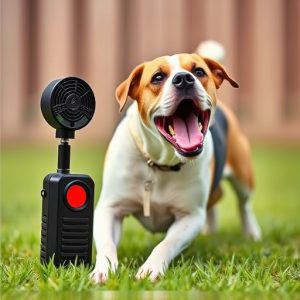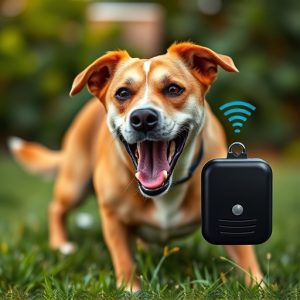Sonic Dog Training: Effective, Safe, and Ethical Correction Methods
Sonic dog training provides a humane alternative to traditional punishment, utilizing ultrasonic sou…….
Sonic dog training provides a humane alternative to traditional punishment, utilizing ultrasonic sounds to correct behaviors like barking and pulling on leashes. This method meets Dog Repellent EMC Certification Requirements to ensure safety and prevent electronic interference. By targeting specific canine hearing ranges, sound waves can effectively guide behavior without causing harm, appealing to owners seeking ethical training options for their pets' well-being.
“Unleash a new era in canine training with sonic dog training, a non-invasive behavioral correction method. This innovative approach leverages sound waves to modify dog behavior without physical contact. In this comprehensive guide, we explore the science and ethics behind sonic training, delve into EMC certification for safe devices, and uncover various repellent types tailored for different scenarios. From understanding the fundamentals to ethical considerations, discover why this method is gaining traction among pet owners seeking effective, responsible dog training.”
- Understanding Sonic Dog Training: A Non-Physical Approach
- The Science Behind Sound as a Behavioral Modifier
- EMC Certification: Ensuring Safe and Effective Devices
- Types of Sonic Repellents for Dogs and Their Applications
- Ethical Considerations and Best Practices for Sonic Dog Training
Understanding Sonic Dog Training: A Non-Physical Approach
Sonic dog training is a revolutionary approach to behavioral correction that leverages sound waves instead of physical force or punishment. This method utilizes specific frequencies and tones to communicate with dogs, addressing unwanted behaviors like barking, jumping, or pulling on leashes. Unlike traditional training methods, it’s completely non-invasive and harmless, ensuring your pet remains safe and undisturbed during the process.
The technology behind sonic dog training involves devices that emit ultrasonic sounds beyond human hearing ranges but are effective for dogs. These sounds can be triggered by specific behaviors, providing an immediate correction without causing discomfort or stress. This approach is especially beneficial for owners seeking a humane alternative to traditional dog repellents, many of which carry EMC certification requirements to ensure they don’t interfere with electronic equipment. By understanding the science behind sonic training, pet owners can explore this innovative method and contribute to their dog’s overall well-being and behavior improvement.
The Science Behind Sound as a Behavioral Modifier
The science behind sound as a behavioral modifier is rooted in the way animals, including dogs, perceive and respond to various auditory stimuli. Sound waves travel through the air and can be manipulated to produce specific frequencies that target the dog’s hearing range. Different tones and patterns can influence their behavior, ranging from encouraging desired actions to deterring unwanted ones. For instance, high-frequency sounds, often used in sonic dog repellents, have been shown to startle animals without causing harm, thereby reinforcing positive training practices.
When it comes to dog repellent devices, the EMC (Electromagnetic Compatibility) Certification Requirements play a crucial role in ensuring their safety and effectiveness. These certifications guarantee that the equipment emits sound within safe limits for both humans and dogs. Additionally, they verify the device’s ability to operate without causing interference to other electronic appliances, ensuring harmonious coexistence in various environments. This scientific approach not only enhances the training experience but also adheres to strict standards, making it a reliable method for modifying canine behavior while addressing potential health and safety concerns.
EMC Certification: Ensuring Safe and Effective Devices
When it comes to sonic dog training and behavioral correction devices, ensuring their safety and effectiveness is paramount. This is where EMC (Electromagnetic Compatibility) Certification plays a crucial role. The certification guarantees that these devices meet strict standards for emitting sounds designed to deter dogs, minimizing potential harm from electromagnetic radiation.
The EMC Certification process involves rigorous testing to ensure dog repellents comply with international requirements. Manufacturers must demonstrate their products’ safety and reliability in various environments, addressing specific EMC Certification requirements. This ensures that the devices are not only effective in training but also pose no adverse effects on dogs’ hearing or overall well-being.
Types of Sonic Repellents for Dogs and Their Applications
Sonic dog training behavioral correction utilizes sound waves to modify canine behavior, with various repellent options available on the market. These repellents emit high-frequency sounds that are inaudible to humans but can deter dogs from specific actions or areas. One common type is the ultrasonic dog repellent, which produces high-pitched frequencies ranging from 25 to 64 kHz. This technology is safe and effective for various applications, such as preventing dogs from barking excessively or encroaching on restricted zones like gardens or trash cans.
Another specialized sonic repellent focuses on mimicking natural predator sounds or emitting low-frequency vibrations to startle dogs without causing harm. These devices are designed for specific behavioral issues like dog aggression or persistent digging. When selecting a sonic dog repellent, it’s crucial to consider factors like range, battery life, weather resistance, and any EMC (Electromagnetic Compatibility) Certification requirements to ensure safety and effectiveness in modifying your dog’s behavior.
Ethical Considerations and Best Practices for Sonic Dog Training
Sonic dog training, while offering innovative solutions for behavioral correction, raises important ethical considerations. The primary concern revolves around the potential harm that such devices could cause to a dog’s sensitive hearing and overall well-being. It’s crucial for trainers and pet owners to understand that these tools should only be used as a last resort and in accordance with strict guidelines.
Best practices dictate that sonic dog training devices, to be effective and ethical, must meet stringent EMC certification requirements. This ensures their safety and effectiveness without causing discomfort or distress to the animal. Dog owners should opt for reputable brands that prioritize animal welfare and adhere to international standards. Additionally, proper training methods involving positive reinforcement and consistent command should always be prioritized before resorting to electronic correction, ensuring a harmonious and healthy relationship between pets and their owners.
Sonic dog training offers a humane alternative to physical correction, leveraging sound as a powerful behavioral modifier. By understanding the science behind it, choosing certified products like EMC-approved dog repellents, and adhering to ethical best practices, owners can effectively address unwanted behaviors without resorting to harmful methods. Whether for barking, aggression, or other issues, this non-physical approach promotes positive reinforcement while ensuring safety and effectiveness.


